Text
“Pride Not Prejudice” exhibit opens in Sausalito June 12
While some might question the use of the name of “Pride Not Prejudice,” for an art exhibition this summer, the correlation between the classic 19th Century novel and this year’s art exhibit at Sausalito Center for the Arts (SCA) celebrating LGBTQIA+ Pride is noteworthy.
When author Jane Austin published her novel “Pride and Prejudice” in 1813, she extolled the “new idea” of marrying for love. And, despite what convention demands, a woman should choose whom she wants to marry.
Historians of Austin and the 19th Century do debate whether or not Austin was ahead of her time. But regardless of Austin’s sense of tradition and convention, she was bold and brave to assert herself.
Here’s where the correlation of the title is to the upcoming art exhibit “Pride Not Prejudice” which opens at SCA during LGBTQIA+ Pride month on June 12.
Like Austin, LGBTQIA+ people have been asserting themselves in various ways even before “Gay Pride” and “Gay Rights” became an official movement or initiative of change.
Yet, also like Austin, many LGBTQIA+ people in previous times and places did whatever they could in their own unique way to choose to love honestly and live authentically. Like Austin this was done in subtle inconspicuous ways and anonymously.
Even as Austin’s work was well-received in her lifetime, her work was initially published anonymously “Unfortunately, the publisher made more money on ‘Pride and Prejudice’ than the author did,” says Mary Mintz, president of JASNA - the Jane Austin Society of North America.
Still, the fact that Austin persevered in her endeavor to write and express herself in the arts helped open the door to equal rights and the Suffragette movement of the early 20th Century.
And so, use of the Austin novel title as the exhibit’s theme is probably most appropriate if not a bit serendipitous.
The diverse “Pride Not Prejudice” exhibit showcases original artworks by 19 accomplished LGBTQIA+ California-based artists. The six-week exhibit is curated by Joseph Abbati and Charles Stinson.
“I am excited to see this exhibit come together,” said Abbati who has been collaborating with Stinson and SCA executive director Shiva Pakdel for several months in the planning. The show which will have an interesting eclectic array of works will also include two and three dimensional art encompassing all mediums.
“Getting all the pieces and works together, hanging and arranging them in the gallery space will be an experience in itself,” said Abbati.
SCA is fortunate to have Abbati as his experience at putting together art exhibits is extensive. “I’ve got eight exhibit/events happening this spring and summer,” he said. “So my plate as it were is full.” “Still, I didn’t want to pass up the opportunity because SCA does a good job with organizing art events.”
“This is the 2nd annual ‘Pride Not Prejudice’ exhibit and it was a nice turn out of attendance,” Abbati said. He’s looking forward to an even greater turnout as SCA’s presence and recognition in the community continues to grow.
Speaking about the title of the exhibit, Abbati said. “I like it!” “People should be proud of who they are and put aside prejudices.”
Pointing to the fact that art is a powerful catalyst for change, Abbati said. “Even if It’s uncomfortable, it’s always uplifting to expose people to things; to new ideas and experiences they haven’t seen, heard of or even thought of before.”
“A reaction from an audience/viewer of art it stirs questions,” said Abbati. “That’s what I appreciate, art can encourage some sort of discourse or discussion.”
Abbati will be featuring some of his work in the exhibit from his series entitled “Shape Shifters.”
“It’s a metaphor, said Abbati (painting a face or image from two different angles) and it represents what many LGBTQIA+ people go through to fit into everyday society.” Interestingly Abbati isn’t alone in his perception, artist and surgeon Don Hershman has a series of paintings that will be featured in the ‘Pride Not Prejudice’ exhibit called, “Code Switching.”
“I did the series in double imagery as a metaphor,” said Hershman. He’s honored to be asked by Abbati to participate in the exhibit. Similar to what Abbati expresses in his series, “it’s what people do to to fit into society,” said Hershman. Just about all people change their way of speaking and acting so to fit into the established norm.”
Yet, while the metaphor of this ‘switching and shape-shifting’ has a universal truth to it that many people can relate to, stringent and often restrictive social norms can be very difficult for LGBTQIA+ people. Which as both Abbati and Hershman noted, raises the question of, “is that fair and just?”
“Society sets up social norms and constructs, some of them are hypocritical,” said Abbati. As someone who worked for years in the corporate sector, Abbati knows how that can disrupt and affect a person’s life. Hershman knows that as well as anyone who has dedicated themselves to a disciplined profession like medicine, the pressure to be “perfect” can be exhausting if not in some ways demoralizing.
Coming from immigrant-stock parents of a working class background, Hershman was urged if not expected to pursue a respectable and stable profession. “I was interested in science and medicine, but I loved art,” Hershman explained.
“My parents were frightened, petrified that my love of art and propensity to draw and do sketching would lead me into a life of poverty.”
It was later in life when Hershman had the opportunity to show his work and then eventually devote more time to it. Fortunately for Hershman, his artistic talent as well as his medical training served him well. Art and science, “surgery and sketching/painting do have a parallel,” Hershman said. “They have a flow, the skills I think complement each other.” For me, it’s fluid, he added.
Hershman and Abbati became acquainted during the “de Young Open” triennial exhibit at de Young Museum in San Francisco, in September of 2023. More than 7,000 artists applied. The competition was intense. Abbati and Hershman were selected to be among the 883 from the nine Bay Area counties to have their work on display at the de Young.
“We have been friends ever since,” said Abbati. Understanding how important it is for artists to come together, Abbati and Hershman see the upcoming exhibit at SCA as not only important but significant.
Noting how far society has progressed, Abbati said. “Gay wasn’t always as inclusive in the past (more than 50 years ago) it was mostly about gay white men.” “Yet now it’s LGBTQIA+ and I like that,” said Abbati.
Commenting on how convenient it is to confine one’s identity to a box, like an item on a check list or some little compartment. “There’s always going to be people who are not ready for a cultural shift,” he said. “Life isn’t as linear as people think,” said Abbati.
One thing about any and all ‘Pride Celebrations’ is that it stirs up people to not just be aware but to think. Think about new ways of thinking and being truly and fully human.”
“Pride Not Prejudice,” an exhibition celebrating LGBTQIA+ Pride Month opens June 14 and continues through to July 7. Meet The Artists reception is on Saturday June 15. Jazz performance and light refreshments will be included. Reception goes on from 5:00 to 8PM.
SCA Gallery is open Wednesday through Sunday, 11:00 AM to 5:00 PM. Sausalito Center for the Arts is located at 750 Bridgeway Sausalito. For more information visit the SCA website.


#Pride Not Prejudice#sausalito#Don Hershman#Joseph Abatti#Charles Stinson#Sausalito Center For The Arts
0 notes
Text
‘Seize the Gaze’ exhibit and the curator, Susan Almazol - truly “Age Defying!”
For artist Susan Almazol, the phrase “age defying” isn’t about a beauty product it’s about energy. And it’s energy or as she calls it “life-force” that she wants to highlight and celebrate in an upcoming exhibit entitled, "Seize the Gaze" opening on May 3.
The exhibition at Joyce Gordon Gallery in Oakland is a captivating immersion curated by Almazol, into the buoyant presence of women of color across generations made possible when women of color themselves determine the gaze -- that lens through which they are seen.
Through bold portraiture, Almazol not only curates the exhibit but is also among the six Asian American, Black, Indigenous, and Latina artists featured. All together, they evoke the profound feminine energies of the sacred, the sensual, and the spirited.
Through their unique perspective of paintings, photographs, digital art, mixed media, and sculpture, the six women invite viewers into an intense and powerful exploration of the limitless spirit of women of color when free of societal constraints.
The "Seize the Gaze" exhibition celebrates the rich tapestry of empowerment and beauty woven by these artists of color.
Almazol took a few moments to speak about her work and a bit about her life.
“I don’t think of myself as ‘all set.’ Life is really an amazing stew of experiences,” she said. And, from her perspective, “old age or rather aging itself can be a continuing evolution of identity."
Almazol has experienced health crises, like others her age, but she's determined to live life to the fullest. “I don’t move as I used to," she said. "But I still want to move and be active.” She added, “All of us are affected by social norms. People have lots expectations and assumptions on how people are supposed to act.”
Yet despite all the norms and expectations, “people are still just people; even if others in general don’t see old people with much identity other than being old,” said Almazol. “Everyone has lots of roles, duties and jobs in their lifetime. They are teachers, parents, managers, director and leaders,” she said. “But when a person gets old, that person in the eyes of the general public is seen and considered as simply old.”
“But, in the circle of friends that I have, no one really ‘acts their age’ as they get older,” said Almazol. “They, like me, are too busy living and wanting to make the most out of life.”
As a visual artist, curator, dancer, and writer based in Oakland, Almazol has always had “a life force” of energy with her. She was uprooted from the Philippines at age 3 because of WWII. After living in Japan, her parents and family immigrated to the United States when she was 5.
These journeys embedded within her an affinity for bold transformation. Not one to question too much why something like a career change or a vocation happens, “I became a ceramics sculptor at 54,” she noted. “And, I danced for the first time on stage at 66.”
But it was in 2017 when she began creating nude self-portraits at age 71 that “I got strong opinions,” she said. “And, some of the opinions were extreme, ranging from support to rejection.”
“What’s interesting," said Almazol "is that up to that point I didn’t get any negative reactions. But it was when I ventured into self-portraits that I realized this form of art provokes strong responses."
Despite the vulnerability in doing art, Almazol continues. Art in any form can be a cathartic experience she said, “In sculpting, for example, when I start I have only a vague idea, and then my hands take over.”
In speaking about her work, fellow artist and colleague Cynthia Tom noted. “Susan and I have known each other for 20 years through the Asian American Women Artists Association.”
As Tom explains. “We were in many exhibits together, but for some reason this last 18 months, we started talking to each other almost daily. We were both sounding boards for each other for different things."
Surprised at first and then impressed by Almazol’s self-portraits, Tom recognized not only the artistic quality of the work but also the “fun, joy, spirit and power” in the work. "I feel like Susan has stepped into her superpower,” she said.
Almazol’s daughter, Octavia Baker, would agree as she said, “My mom is an explorer, a risk taker, and a doer.”
“I nicknamed her ‘can't stop, won't stop,’" said Baker, "for her endless curiosity about the world around her and her prolific ability to create in many art forms.”
Very proud of her mother and the tremendous strength and vitality she radiates, Baker said. “I'm always inspired by her courage to be (more than ‘age-defying’); she’s 'expansive and uncontainable.’ Those are words from her favorite author, Chitra Banerjee Divakaruna.”
‘Seize the Gaze’ opens May 3 and continues for eight weeks through June 29 at Joyce Gordon Gallery located at 406 - 14th St. (between Broadway & Franklin) in downtown Oakland. For more information, visit the Joyce Gordon Gallery website. (Photos: Chris Matos)
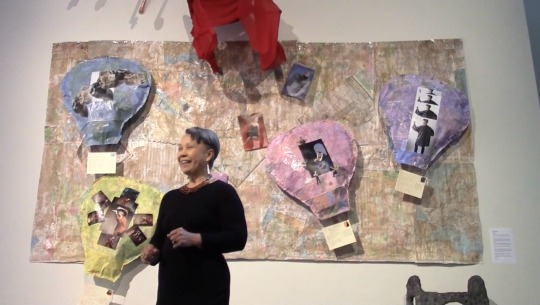

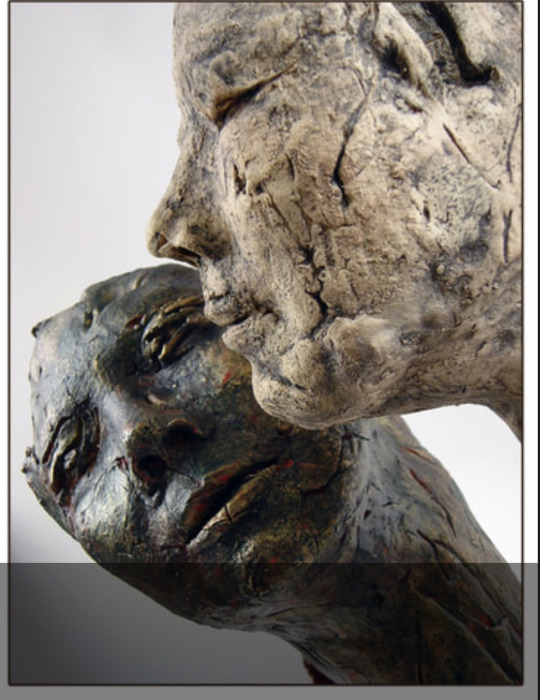
0 notes
Text
Was Shea Butter Part of Cleopatra’s Beauty Regime?
As the weather turns from winter into spring, no doubt those seeking to be outside will need to moisturize their skin as the shift in temperatures with sun, water and wind make an impact. Skincare product specialist, Caryl Brandes of Caryl B has just “the thing for spring” and that is Shea Butter.
“Shea Butter is extracted from shea nuts from the Karite tree,” said Brandes. “Shea Butter is known for its luxurious moisturizing properties,” she added and Shea Butter melts at body temperature making it easily absorbed into the skin.”
The word ‘Karite’ comes from the French who established a colonizing presence in West Africa where the Shea Tree grows. Known by the people of the Senegal as “ghariti,” The Shea Tree grows naturally in the wild in the dry savannah belt of West Africa from Senegal in the west to Sudan in the east, and further onto the foothills of the Ethiopian highlands.
“It is a great choice for dry, irritated skin,” said Brandes. “It has been well-documented to improve the appearance of scars and stretch marks,” she noted.
Dermatology specialist Dr. Debra Jaliman, MD agreed as she said. “Shea Butter is very moisturizing.” It’s good as long as you aren’t acne prone.”
Still even so, Shea butter has anti-inflammatory properties, which can soothe and repair sensitive skin reducing the effects of skin conditions such as psoriasis and eczema.
Because of its emollient properties, such as the fatty acids and vitamin-rich oils produced by the seeds-nut-kernels, it’s believed that people in ancient times such as Cleopatra used Shea Butter.
“Fortunately I cover this throughout my book 'Cleopatra the Great' (published by Harper Collins),” said Professor Joann Fletcher, PhD an Egyptologist at The University of York in England.
“The perfumes available during Cleopatra's time were many; said Professor Fletcher, using everything from rose and myrtle oils to cinnamon and wine, plus various cleansing creams, bathing products and cosmetics.”
Fletcher noted, “there are lots of websites claiming Cleopatra used pretty much every product out there.” But, as she pointed out with regard to such beliefs, “this is almost always inaccurate.”
“I haven't come across any references of Cleopatra using shea butter either in my research for my biography of Cleopatra, or in our chemical analysis work here in the lab,” said Fletcher.
And while that might be a disappointment, it doesn’t diminish or take away the qualities or efficacy of Shea Butter. Besides, where the Shea Tree has traditionally been grown in West Africa, Egypt is over 2,000 miles away.
Regardless of whether or not Shea Butter was used in Egypt since ancient times, the current popularity of Shea Butter continues to grow. Shea Butter harvesting brings in around $200 million every year for the West African region, according to some accounts. And, according to others such as Polaris Market Research, in 2023, the global Shea Butter market is valued at over $2 billion dollars.
Naturally this is happy news for skincare product manufacturers like Caryl Brandes who has been making exceptional skincare and bath products for 10 years.
Caryl B’s ‘Calm Woods’ and ‘Healing Hand Cream’ are made with an exceptional high percentage-quality level of Shea Butter. Both these are now available. As Brandes emphasized, “just a small amount is needed to keep your hands soft and moisturized throughout the day.”
To learn more about these high quality Shea Butter products available, visit the Caryl B website.

0 notes
Text
Another “Sword & Sandal” movie for Easter time
An interesting move, well acted (it stars Joseph Fiennes, brother of Ralph) and production quality good. But it isn’t historically accurate. The premise/perspective from the Roman point of view is unique but it’s inconsistent.
Movies such as this are based upon historical novels. “Ben Hur,” “The Robe,” “The Silver Chalice,” are all based around historical novels. And in the situation of the novel “Ben Hur” turned out to be very successful and well-received.
Embellishments and “stretches of truth” do occur but it’s based upon what is known and understood.
When ‘Risen’ gets a simple fact known, wrong that takes away its attempt at a realistic interpretation.
The simple fact I noticed immediately was that of “the Marys.” (Where in the New Testament does a Roman consider to speak to Mary the Mother of Jesus?) Especially that of Mary Magdalena.
It’s been an established fact (even the novel “The da Vinci code” highlights it) that Mary of Magdalena wasn’t “a woman of the street” as the movie’s dialogue says.
‘Risen’ reminds me of the very well produced Franco Zeffirelli made for TV series, ‘Jesus of Nazareth’ (1977) and Mel Gibson’s “The Passion of The Christ.” These were made meticulously to reflect historical accuracy. Well, what’s up with this movie, ‘Risen?’
The realism is there and it’s striking to say the least. But what’s the point if facts are not upheld! It’s doubtful that a Roman Tribune would be hanging around the Apostles (for the New Testament says they were in hiding) and spending time with them just as Jesus makes his resurrected visit to the Apostles and then again with the ascension into heaven, that’s very unlikely.
I thought it interesting that like in previous “sword and sandals” Biblical epic, type movies, Romans or overlords have British accents. It’s kind of a tradition or maybe an unintentional habit?
And maybe the overlooking of certain historical facts and making very stretching embellishments is also an unintentional habit here in the movie ‘Risen.’
Even though this is the situation, the movie has some insight and entertainment value.
If you like realism in battle scenes and rustic biblical period pieces then ‘Risen’ is a movie to see. Avoid eating anything for the very first part, the crucifixion scene is brutal and you might barf up your popcorn and soda.
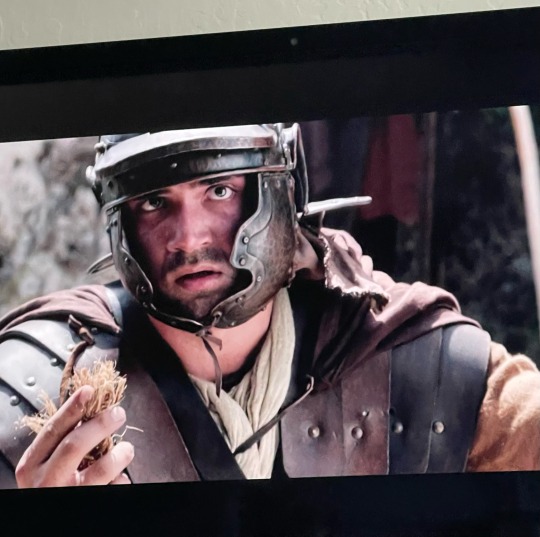
0 notes
Text
Something For The “Green-Thumb-Inclined” this Spring
As winter will officially close this year when the Spring equinox lands on March 19, thoughts easily meander to flowers and gardens.
Once the rains subside “the green-thumb” inclined will be eager to tend to the soil. Hyacinths, tulips daffodils and lilies will be in full bloom soon to a garden-lover’s delight. While handling dirt appeals to the child in us, like playing in the mud, many types of soil absorb and pulls out moisture and oil from the skin.
Even, if working with gloves, hands still need moisturizing care, says Caryl Brandes, a skincare product professional, who just participated in the Marin Arts & Crafts Show and marketplace this past February 23 to February 25.
Just in time for spring, she has developed and created a new skin cream ideal for soil-tenders & horticulture enthusiasts. Labeled simply “A Gardener’s Healing Hand Cream,” Brandes has put together a unique new formula-mixing Orange and Rosemary with a blend of Tamanu or Foraha oil.
“This cream was created for those with dry, rough, callused, and cracked skin,” says Brandes. “Skin areas such as hands, feet, elbows and knees, I also kept in mind,” she added. Gardening also involves being down in the dirt on hands and knees, sometimes up to the elbows.
Adding the oil from the Tamanu tree into the compound, this new hand cream product is made with the oil extracted from seeds or nuts of the tree. The Tamanu tree, as described by Wikipedia, is from Polynesia-Asia and parts of Australia.
While the Tamanu tree does have fragrant flowers and its oil is beneficial, it isn’t to be eaten or ingested. It’s strictly an externally used oil for the skin.
As noted by Dr. Debra Jaliman, MD on WebMD, “it is often used in skin care for its wound-healing properties.” It’s sometimes thought of as an essential oil. But as Dr. Jaliman explained. “It’s actually a fatty nut oil, which can be used to dilute and or facilitate essential oils to heal the skin.” (Those with nut allergies might take precautions, testing a tiny bit on skin first before considering to buy).
Even so, Brandes upholds the benefits as she said. “It offers deep hydration and protection for the skin, while offering the wonderfully soothing fragrance of Orange and Rosemary.”
This new product is an addition to the Caryl B ‘Gardener’s Collection.’ “It’s perfect for gardeners, farmers, and carpenters,” exclaimed Brandes.
Maintaining the highest quality for her artisan-boutique approach to specialty products, all of Brandes’ skin and bath products are made in small batches to ensure exceptional quality and consistency.
“When I started my line of skin, bath and personal care products almost a decade ago, it was with sensitive skin in mind,” said Brandes.
Brandes is always seeking new and innovative ways to help enhance the skincare, bath and personal care products she provides.
“Foraha or Tamanu ( which is same species), says Brandes is a plant whose seeds (or nuts) are used to treat wounds, rashes, burns and other ailments.” That’s why she sought it out.
“I have made a compound-mixture that is gentle yet effective,” said Brandes. “Use as often as needed for a calming skin-cellular repair treatment.”
Visit the Caryl B website to learn more about the new addition to ‘Gardener’s Collection’ now in Orange & Rosemary with Tamanu oil.

0 notes
Text
Chris Felver's ‘Whole Shebang’ with Douglas Sandberg, Photos, Films, and Paintings
On the heels of the recent Figurative Art exhibit that highlighted the Figurative Art Movement of the Bay Area, comes the varied work of Chris Felver, opening at the Sausalito Center for The Arts (SCA) on March 20.
Felver took some some time to speak about his work and his life. “I want this exhibit to show what’s up-to-date about my work, he said, a canvassing which includes my films.”
Spanning decades, Felver’s work is more than just one thing. Describing himself as “an artist,” “I go with that over anything else like photographer, filmmaker, painter, the title of ‘artist’ is much easier,” he said.
And, that’s how he sees it, but also perhaps because that’s how he has experienced the journey of his remarkable career.
Born and raised in Akron, Ohio, Felver initially followed the basic path. If he had remained in Akron, (in a conventional way) he would have eventually gotten a job in the tire industry or something similar.
But he knew instinctively that staying in an industrial town known as the ‘rubber capital’ wouldn’t make for an interesting life. So he acquired Akron’s other most cherished thing of golf and took off for the University of Miami in Florida, joining the golf team.
Playing for the university’s team along with other pursuits while at University of Miami he sensed there was more on the horizon. He then joined the U.S. Army.
After his time in the military, he ventured to Arlo Guthrie’s song-famous, Alice’s Restaurant or rather ‘The Back Room’ as was actually called in Stockbridge, Massachusetts. It was the 1960s and the conservatism of the 1950’s was buckling under the wave of change.
Eager for new ideas, sights and sounds, Felver went off to Europe and was busking, singing and playing guitar in London. While there he found himself at film school and then at the London College of Painting.
His infatuation with Europe then got overtaken by an even greater interest, which he got a taste of in Stockbridge.
As mentioned, the world after World War II was changing and there was an excitement about it that was referred to as ‘The Beat Generation.’
“I was fascinated by them,” said Felver. “Their poetry, their non-conformist nature, I identified with them.” Even as the 1960’s marked a distinct period somewhat separate from the Beats, the Beat Generation is what opened the door and paved the way for the civil and social revolutions that were approaching.
“It all began right there and I just kept on going,” he said. Felver made his way back to the United States and was in Los Angeles for a while. “Hollywood is hardly the place (even then to hang out for artists),” he noted.
So, he went with the flow and made his way to the San Francisco Bay Area. “As soon as I got here, I just knew that this is it. Can’t miss it! I’ve been here ever since.”
North Beach in San Francisco was a special place, “All the luminaries were still there when I arrived,” said Felver. His ongoing interaction and friendship with the’Beat Generation,’ would eventually lead to several books. And this includes a film about City Lights Bookstore founder and prominent Beat writer/poet, Lawrence Ferlinghetti.
Looking back on those days, Felver said. “That level of cultural sophistication doesn’t exist anymore. North Beach is a different scene now, my friends are gone,” he added.
“What stands out to me about the Beat Generation said Sausalito Plein air artist Kay Carlson, is that they portray the human condition with non-conformity, and celebrate spontaneous creativity in many genres.”
She refers to the Beat Generation as “luminaries,” Carlson points to their unique cultural significance. “They are a thread that has persisted since the 1950's, she said, when the literary subculture including Kerouac and Ginsberg and Hunke on the East Coast influenced the visual arts, music, cultural and attitudes.”
Carlson understands why Felver was and has been continuously inspired by the Beat Generation.
“They reject the standard narrative of values, including materialism and make spiritual quests,” she said.
Pointing out the reasons for the Bay Area’s ability to attract this significant movement at pivotal time in America history, Carlson said.
“Sausalito and the waterfront has long been home to this Beat Generation movement.”
Citing the many accomplishments of Felver, Carlson noted. “Chris is a cultural documentarian. His distinctive visual signature is a lasting contribution to the legacy of our national cultural community.”
In addition to his photography and paintings, 10 of his films will be featured.
“The little film fest at SCA will be a sidebar to the exhibit,” said Felver.
His documentaries have captured the spirit and creativity of many international artists and include The Spirit of Golf (2020); Anthony Cragg: Inside/Outside (2020); Ferlinghetti: A Rebirth of Wonder (2013); Cecil Taylor: All the Notes (2005); Donald Judd’s Marfa Texas (1998); The Coney Island of Lawrence Ferlinghetti (1996); Tony Cragg: In Celebration of Sculpture (1993); John Cage Talks About Cows (1991); Taken by the Romans (1990); West Coast: Beat & Beyond (1984); and California Clay in the Rockies (1983).
Felver’s films & photographs reads like a roster of American mid-century avant-garde.
Aside from his extensive photography portraits, Mr. Felver has also produced another body of work entitled: Ordered World.
About this body of work, curator, James Crump writes, “Mr. Felver celebrates the elemental essences manmade and natural objects that tend to elude observation. Working in a manner not unlike sculptor & photographer, Karl Blossfeldt, Albert Renger-Patzsch and the New Objectivity artists of 1920s and ’30s Germany.”
“Felver, says Crump, asserts his own contemporary vision here. His pictures are informed by Minimalism and the keen, refined observation of a poet unwilling to discard the mundane or topical content that surrounds us but, nevertheless, is overlooked in the quickened pace of our technologically frenzied age.”
Noting further Crump said. “The series, while concerned with monumentalizing and focusing our attention on the ordered and structured surfaces of objects, resists any historical referencing to the hardened gaze of the twentieth century. It asks the viewer to ruminate on the overlooked beauty which surrounds us, the wonderment that unfolds, with careful and refined examination.”
Even though Felver’s work is extensive and can fill the entire SCA space and then some, he wanted to share the spotlight with fellow photographer/filmmaker/artist, Douglas Sandberg.
“I am honored to have my work shown,” said Sandberg. “But really Chris’ work deserves recognition because I agree with Kay Carlson, Chris is among those ‘new luminaires’ because he’s carrying on the legacy of the Beat Generation.”
Mentioning how much the Beat Generation influenced her work, Carlson sees Felver and Sandberg both as “New Luminaries.”
She explains a bit more, “I call them (Felver and Sandberg) ‘New Luminaries’ because they bring to light with their artwork to this style of reinforcing creativity.”
“There is a large recent resurgence of this type of spontaneous painting using life experiences,” Carlson said.
“We want to celebrate Chris and Doug as longtime residents of our town, she added. And, give the community the opportunity to know and appreciate them with their amazing history.
“For these two artists have both been
influential on the West Coast, New York, and Internationally,” said Carlson.
Chris Felver's Whole Shebang with Douglas Sandberg,
Photos, Films, and Paintings, will be on display at the Sausalito Center for The Arts, from March 20 to April 14.
For details visit the SCA website.


0 notes
Text
A Sausalito Artist balances his many talents “Between Fire & Ice.”
The Sausalito Center for The Arts (SCA) is delighted to present its next exhibit by two Sausalito luminaries. They are: Chris Felver's "Whole Shebang" and Douglas Sandberg's "Between Fire and Ice.“
Speaking about the upcoming exhibit on March 20 Sandberg took some time to reflect. “It’s an honor to have been invited to participate in this exhibit alongside Chris,” he said. Noting how expensive Felver’s work is, Sandberg added, “it’s something that is long overdue, Ian happy to see Chris in the spotlight.”
Yet regarding his life and work, Sandberg said, “the mantra I want to embrace for the exhibit is ‘Things are heating up, so it’s best to stay cool.’ Art, photography and filmmaking have always been prominent in my life,” said Sandberg.
He remembers vividly an afternoon at the beach in Pt Reyes when, “My father told me about a subject that would change the trajectory of my life right then and there at eight years old.” “It would change my life forever,” he exclaimed.
“My father said that creativity is a very important human endeavor,” said Sandberg.
And Sandberg went on to share that his father was going to his boss and ask for funding on a film entitled ‘Why Man Creates.’
“A year and a half later, said Sandberg, my father brought home an OSCAR.”
“And, that experience, said Sandberg, set me off on a career path of creative pursuits.”
Sandberg’s life has been contributing photography and video to design firms, start-ups, galleries, museums and auction houses since 1979. During that time he has been a champion of unique and innovative art, such as the work of Christo and Jeanne-Claude.
Enamored of such art, since the mid-1970s, when the Running Fence Project by Christo was installed in Marin and Sonoma, Sandberg has continued to push himself artistically and creatively.
An alum of the California College of Arts and Crafts, Sandberg received a degree in Film Arts, with distinction. In addition to working with filmmakers, he enjoys putting together “big art” books, among Sandberg’s various endeavors.
“Douglas has always painted,” said Helen Frierson. She is an author and former executive administrator for the Office of the President at California College of the Arts. Frierson is pleased that Sandberg will be part of the exhibit. As she said.
“His art challenges us to think about contemporary issues,” she continued. “It’s compelling- even ‘urgent-in your face,’ Frierson exclaimed. “You can’t avoid being enveloped in the sensuous painterly quality of Douglas’ brushstrokes,” she said. “Even his smaller works possess a grand scale,” said Frierson.
From his very first jobs directing the photography output for the catalogs of Butterfield & Butterfield, Sandberg understands the power photography has as not only in documenting but in photography’s ability to evoke memories and deep emotions. This understanding and skill he brings to every aspect of his work in a career that spans over 40 years.
“Douglas Sandberg’s work is inventive all the time,” said Bob Green of Robert Green Fine Art in Mill Valley.
“Douglas’s work shows little preconception,” Green said. “He exhibits the essence of raw emotion and feeling in everything he does” explained Green. Also pleased that an exhibit will feature his work, Green is Douglas Sandberg’s current art dealer.
“He exhibits the essence of raw emotion and a feeling with every brushstroke, said Green.
Photos, Films & Paintings Chris Felver’s "Whole Shebang" and Douglas Sandberg’s “Between Fire & Ice,” opens on March 20th. And, it continues until April 14. The exhibit is available to the public Wednesday through Sunday from 11:00 AM to 5:00 PM. For details visit the SCA website.
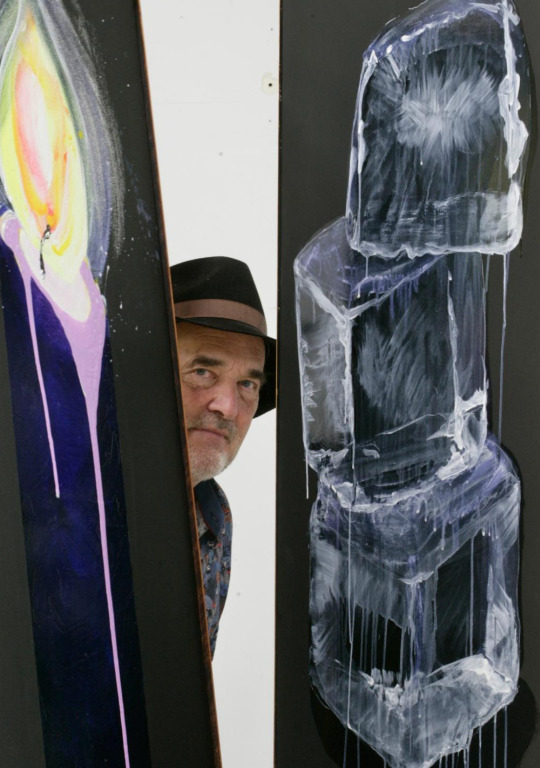

#Sausalito Center for The Arts#Douglas Sandberg#Between Fire & Ice#Chris Felver#Butterfield & Butterfield
0 notes
Text
A Tribute to The Golden Gate Bridge with the nod of a Bobblehead.
For Westside residents of San Francisco there’s nothing more glorious on a sunny day than to see the Golden Gate Bridge in the distance.
Whether from atop a steep incline of 22nd Ave at Noriega, a bay window view from Forest Hill/Sutro Heights or even the sweeping spectacular vantage point of the Legion of Honor at Lincoln Park near the Richmond District, there’s something reassuring about the Golden Gate Bridge.
In honor of the 90th anniversary of it’s construction which initially began on January 5 1933, The National Bobblehead Museum and Hall of Fame unveiled the first of its kind to commemorate the building of the Golden Gate Bridge.
“The limited-edition bobble creation is being released in conjunction with the anniversary of the start of the bridge’s construction, which began on January 5th, 1933, as well as National Bobblehead Day, which the NBM & Hall of Fame established nine years ago and is celebrated annually on January 7,” said the museum’s CEO and co-founder Phil Sklar.
Bobbleheads have made a resurgence in recent years, especially with baseball fans. In fact in the 1960s the first ‘player-specific’ bobbleheads were made/introduced.
Although as Sklar pointed out. “Nodding-head figurines can be traced back as far as the the mid-1700s.
Sklar also noted. In the 1960s, not only were San Francisco Giants baseball stars like Willie Mays merchandised but The Beatles were too at the height of ‘Beatlemania.’
“The Beatles bobblehead set was made in 1964 and became one of the most famous and rarest of all time,” said Sklar. “It is still a valuable collectible today,” he added.
Depending upon the condition and edition, some of the various Beatles bobble-head sets can sell anywhere between $300.00 to over $1,000.00.
Because of nostalgia for these unique figure-forms, their resurgence in the 1990s and their traceable extensive history spanning at least 300 years, Sklar and Brad Novak established the National Bobblehead Hall of Fame and Museum in 2014.
“The resurgence of bobbleheads was due in large part to the SF Giants giving out over 35,000 bobbleheads of Willie Mays at the May 9, 1999 game,” said Sklar. The interest in bobbleheads has continued and grown ever since then.
Housing more than 10,000 bobblehead figures from all around the world, Sklar & Novak wanted their hometown of Milwaukee, Wisconsin to be known for something more than just beer brewing.
In addition to housing one the most extensive collections and exhibits of bobbleheads, the museum and hall of fame facility has bobbleheads custom made.
“We have produced bobbleheads of several iconic landmarks recently, said Sklar, like the Eiffel Tower, Statue of Liberty, and Leaning Tower of Pisa.” He spoke briefly to The Westside Observer by phone. He emphasized why the one they made for the Golden Gate Bridge is special.
“When looking at other potential landmarks, the Golden Gate Bridge rose to the top of the list quickly,” he said.
“This is the first Bridge Bobble that we've done,” Sklar said. And while, “there are a few other bridges that have been bobbled before. It is the first Golden Gate Bridge Bobble though,” he said.
“It was while visiting San Francisco and seeing the Golden Gate Bridge in person, said Sklar that was definitely part of the inspiration.” Referring to it as one of “most internationally recognized symbols not only of San Francisco, but of California,” said Sklar, he pointed out that the Golden Gate Bridge has an impressive history.
Completed in 1937, the 4,200-foot art deco suspension bridge links the city of San Francisco to its northern neighbor, Marin County. It spans the what was called by early settlers and pioneers as ‘the Golden Gate,’ which is the one-mile strait between San Francisco Bay and the Pacific Ocean.
Despite its name, the bridge is painted a reddish orange, not gold. The bright color, called “international orange,” often can be seen through the fog that forms over the bay. Initially designed by engineer Joseph Strauss in 1917, the bridge took four years to build, starting on January 5th, 1933. When the Golden Gate Bridge opened,The San Francisco Chronicle called it a “$35 million steel harp.”
At the time of its opening, it was both the longest and tallest suspension bridge in the world – a record it held until 1964.
The National Bobblehead Museum and Hall of Fame is now selling the one-of-kind bobblehead creation of the Golden Gate Bridge through it’s website. “The bobbles, said Sklar, are $30 each plus a flat-rate shipping charge of $8 per order.” Visit the museum’s online store for details.


0 notes
Text
Turn of A Potter’s Wheel, A Sonoma Artist Recollects on The Figurative Art Movement of the San Francisco Bay Area
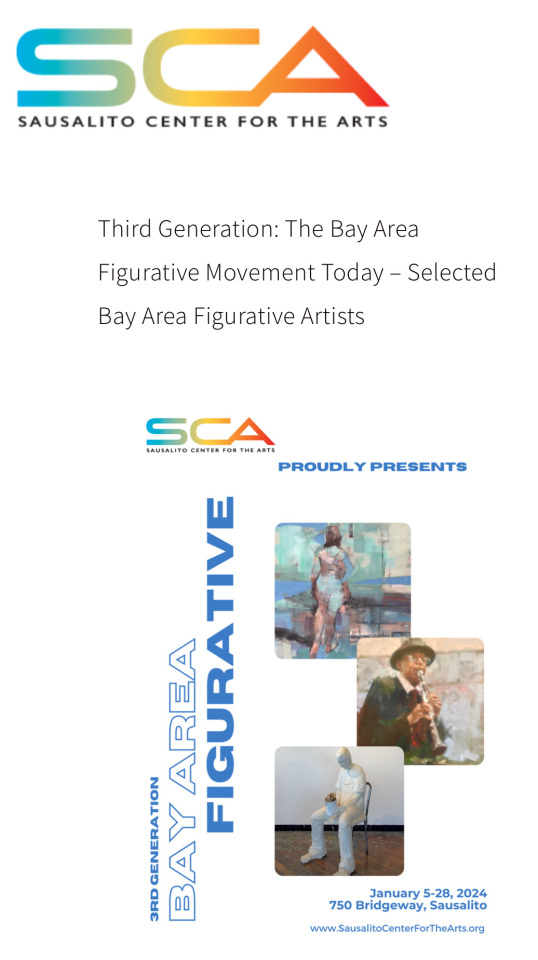
Upon learning about the current exhibit at the Sausalito Center for The Arts (SCA) entitled “Third Generation: The Bay Area Figurative Movement Today,” Sonoma artist and former mayor Larry Murphy was taken aback.
“If I had to spend the rest of my life looking at only one school of art it would be that group of artists,” he said. Murphy recollected his younger days coming of age just as the 1960’s had begun to change the world.
As a San Franciscan he witnessed and experienced the cultural shifts and trends that was redefining post-World War II America. San Francisco and the Bay Area was experiencing a vibrant and diverse energy that had its own style, palate of colors, tastes and even it’s own rock and roll sound.
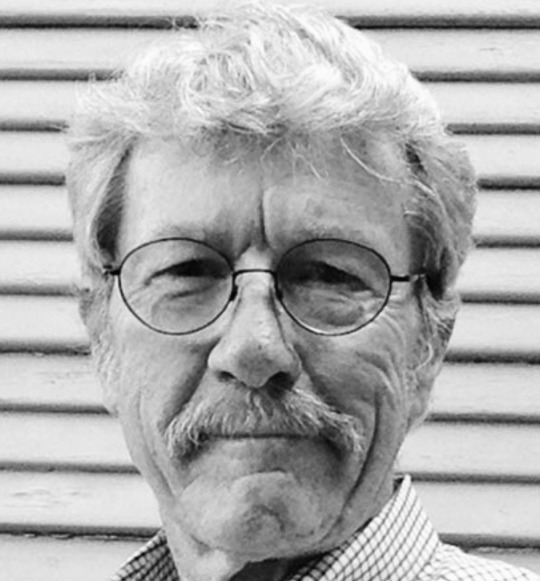
As an artist he was attracted to pottery and watercolor, the San Francisco Art Institute was a hub at the time. Artists and designers from all over the country were coming to the Bay Area to see for themselves what the West Coast was doing.
After World War II everything in terms of culture was focused on America, and the center for art, wasn’t Paris or Amsterdam, it was New York City. Abstract art was a major influence with works by Jackson Pollock and conceptual, minimalist and pop art.
Yet as young people went westward to California for sunshine and “The Summer of Love,” art in the Bay Area was firmly figurative.
Murphy explained, “I studied under Joan Brown, I love Nathan Olivera, Robert Arneson, Wayne Thiebaud, Richard Diebenkorn especially him!” He said. “And Manuel Neri, along with many others.”
Those he mentioned are like a “who’s who” of the Figurative Movement of the Bay Area, especially those artists that would profoundly impact those artists of what the SCA describes as “The Third Generation.”
“To me the most exciting things about these artists, said Murphy is their bold compositions.
“But, especially the way they used thick rich globby paint textures, he added. Murphy who still finds time to paint, exclaimed. “They make me drool!” Suddenly pinpointing a specific recollection he blurted out. “Oh lord, also the brilliant sculptor Stephen deStaebler.”
“And, Also Peter Voulkos,” he said. “Along with Viola Frey, she was another of my teachers,” said Murphy.
Confirming Frey’s work and impact upon the Figurative Movement in the Bay Area, speaking on behalf of the Artist’s Legacy Foundation, Cynthia de Bos said. “Despite Abstract Expressionism’s dominance in the art world at that time, Frey made a conscious decision to embrace figurative art after she saw Richard Diebenkorn’s figurative show at Poindexter Gallery in New York in 1958.”
Serving as the foundation’s Director of Collections and Archives, de Bos also pointed out that, “Frey did indeed embrace the figure from as early as her student years from 1953-56.”
Similarly, especially with the art of Stephen de Staebler, it’s no surprise that as a pottery maker Murphy is an enamored fan. Applauded as a sustainer in the figurative tradition, during the post World War II era, de Staebler was an important figure in the California Clay Movement.
Murphy at the insistence of his wife Rose transferred to California College of The Arts and obtained a Master’s degree in Fine Arts.
This then eventually lead Murphy and Rose with their burgeoning young family to move to the Sonoma Valley. Murphy accepted a teaching position at the prestigious Justin-Siena, and a more settled life for him and Rose began.

After teaching art for more than 15 years, when he retired from Justin-Siena, Murphy became a pub owner in town. He later became Mayor of Sonoma. As the responsibilities of being mayor and pub-owner were stressful, Murphy still managed to keep his artwork going.
An avid fly-fishing enthusiast many of Murphy’s watercolor paintings are of scenes of lakes and streams of those fly-fishing trips. Whereas he described to KQED Perspectives, “to put myself in that beautiful place where nature is mostly untroubled by human intervention.”
Murphy doesn’t do poetry as much anymore. It’s messy and watercolor painting is more portable, he can do anywhere. Even though watercolors seem simple, to master the technique and medium of watercolor painting takes work, focus and patience.
As he used to say to his students, “there’s no such thing as ‘instant art.’ “Pop art often makes that impression. But real true art takes work.”
Reading over the exhibit program at the SCA website, Murphy reiterated the teachers and artists he knew. The Figurative Art Movement of the Bay Area did make an impact, one he remembers with affection and admiration.
“Spectacular stuff in my view, he continued, I have left out dozens of really exciting artists,” he said.
Third Generation: The Bay Area Figurative Movement Today is currently on view at SCA from Jan 5-28th, 2024. A Reception will be held on Saturday, Jan 20th, from 2 to 5pm. Refreshments will be served. For more details, visit the Sausalito Center for The Arts website.
#sonoma#Sausalito Center for The Arts#Figurative Art Movement Bay Area#larry murphy#Catherine Merrill
0 notes
Text
The Bay Area Figurative Art Movement is Not Dead!

When most people think about art and the movements that shaped it in our society, they usually think of places like Paris or New York. Yet few know that one of the most significant art movements was centered right here in the San Francisco Bay Area. It's called, "The Bay Area Figurative Movement".

On January 5, Sausalito Center for The Arts (SCA) installed one of largest and most comprehensive Figurative Art exhibits of its kind with over 18 artists displaying up to five pieces each. “Sausalito Center for The Arts has the space for it and we are so pleased and honored to provide it,” said SCA Executive Director Shiva Pakdel.
The exhibit entitled ‘Third Generation: The Bay Area Figurative Movement Today,’ is curated by established artists Susan K. Kirshenbaum and Catherine Merrill, (seen in photos above). They are also participants in the exhibit. Their individual careers in art span the period from what is regarded as ‘the First Generation’ ‘the Bridge Generation,’ and ‘the Second Generation.
Both curators spoke about how much the exhibit means to them and the other participating artists. As they explained and as websites like The Art Story. The Bay Area Figurative Movement (also known as the Bay Area Figurative School; or Bay Area Figurative Art, Bay Area Figuration, and similar variations) was a mid-20th Century art movement founded after World War II in the 1940s. It was made up of a group of artists in the San Francisco Bay Area who abandoned working in the prevailing style of Abstract Expressionism in favor of a return to figuration in painting.
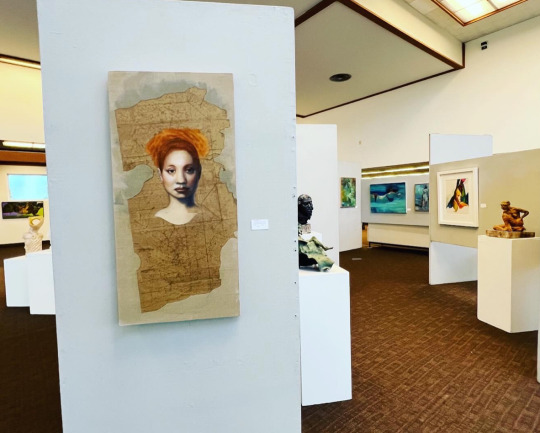
“The art history textbooks say the movement ended,” said Kirshenbaum. “It didn’t end, it’s still going on!” She exclaimed. “We describe ourselves as ‘The Third Generation’ of the movement because we are the group of Figurative artists that are post-1970 and beyond,” said Kirshenbaum. “We may not be included in the textbooks yet,” she added.
(Seen in this photo is participating artist Charles Stinson).
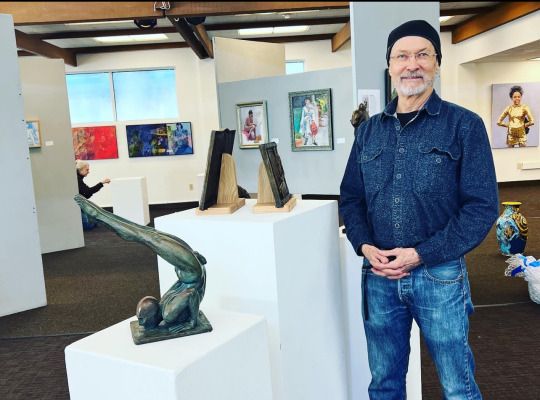
The use of live models is important to this type of artwork,” said Merrill as her work is primarily sculpture and the human form. “People (especially Americans) often get upset over the depiction of the human body in art. I don’t get upset,” said Merrill, I celebrate it.”
Figurative art is basically any art (be it painted, sculpted or sketched) that illustrates real life forms and imagery. A model can be a person or anything that is from actual real life that the artist uses as inspiration to draw, paint or sculpt.
(Seen here in photo is artist, Mary Graham)
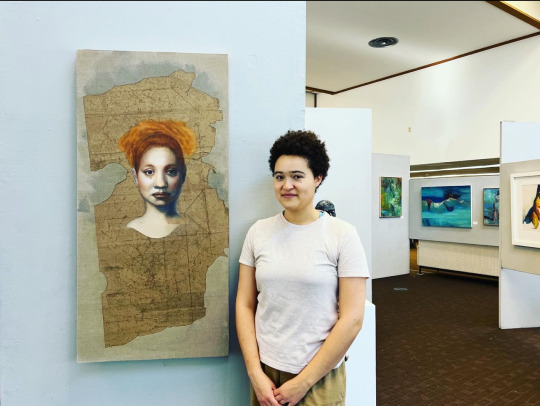
Figurative art has been going on for centuries,” said Merrill, from the ancients to the Renaissance period and beyond.” Both Merrill and Kirshenbaum chimed almost in unison “It has always been with us!”
Merrill wanted to clarify that the reason the exhibit at SCA is so significant is because as she said. “We as a culture are in the midst of the technological revolution,” she said. “But Figurative art is about working with one’s hands, rolling up one’s sleeves and connecting to the work, it’s not on a screen, added Merrill, it’s live.”

“I’m not interested in the abstract concept art that doesn’t express humanity,” said Merrill. Kirshenbaum agreed, saying “the live interaction between artist and model/scenery builds a story from it.”
This is not to say that artists like Kirshenbaum, Merrill and others shun technology. It’s just that they can see where important skills are being lost or under-utilized. “I use digital technology to help in my art,” said Kirshenbaum. “But I can see were that the basic foundations of art making is are not being taught as much in art schools.” “I consider technology a tool, said Kirshenbaum, but an artist must have learn the basic skills; sketching-drawing, painting, sculpting and so forth.”
In putting together the exhibit, Pakdel, Kirshenbaum and Merrill wanted the works featured to be extensive, diverse and inclusive of as many of the top Bay Area figurative artists as possible, providing each artist with a mini-show within the show. “This type of art takes work, said Merrill, while the hands and the brain are integrated, there’s an intrinsic connection that goes beyond thoughts in the head.” “The human body, said Merrill, and the entire physical world is so alive it thinks on its own apart from what we think and get stuck on just in our heads.”
COVID-19 made a considerable impact as Merrill noted. “The pandemic isolated us from one another and distanced us from the galleries.” “Yet ironically the isolation of the pandemic pushed some artists to do some of their best work.”
The exhibit hopes to express not only the talent of the participants but also the joy at being able to gather and experience art together as a community. The participating artists are: Joseph Abbati ~ Douglas Andelin ~ Madelyn Covey ~ Jane Fisher ~ Mary Graham ~ Isidoro ~ Susan R. Kirshenbaum ~ Catherine Merrill ~ Stephen Namara ~ Diane Olivier ~ Sharon Paster ~ Fernando Reyes ~ Alex Rosmarin ~ Randall Sexton (deceased) ~ May Shei ~ Sandra Speidel ~ Peter Steinhart ~ Charles H. Stinson
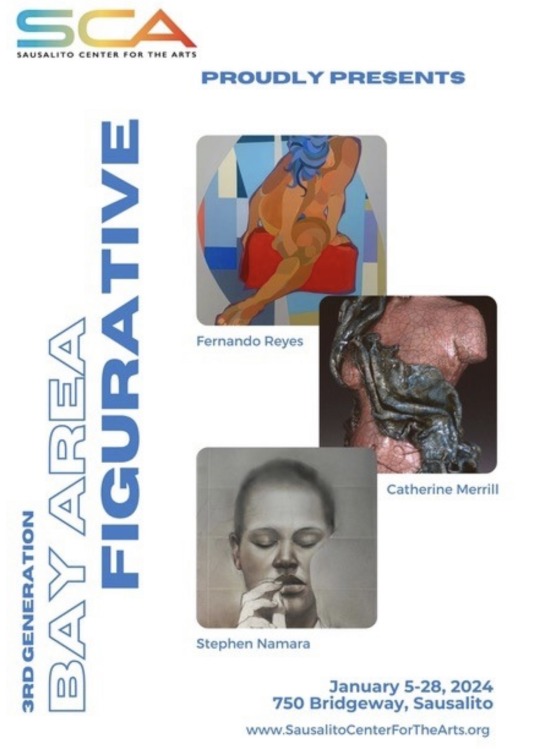
‘Third Generation: The Bay Area Figurative Movement Today’ exhibit will be on view at SCA from Jan 5 until 28th, 2024. A Reception will be held on Saturday, Jan 20th, at 2 PM until 5 PM. Refreshments will be served and there will be live music.
A Closing Party will take place on Sunday, Jan 28 from 3-6 PM, including a Book Talk, a Roving Art Model, and Artist Talks. For more information visit the Sausalito Center for The Arts website.
#sausalito#Figurative Art Movement of SF Bay Area#Susan R Kirshenbaum#Catherine Merrill#Shiva Pakdel
3 notes
·
View notes
Text
Christmas Concludes with Epiphany Celebration in Sonoma

The conclusion of the Christmas season was celebrated at St. Leo’s parish on January 6 in Agua Caliente. The congregation that Sunday commemorated Epiphany or as it is referred to as the visit of The Magi to Bethlehem.
As part of the 12 Days of Christmas from Dec 25 to January 6, the tradition of commemorating the visit of the Magi has been upheld for centuries. In some cultures the giving of gifts is done on January 6 because it was the Magi that gave gifts of gold, frankincense and myrrh.
The Magi followed a star and it lead them to Bethlehem as the narrative says in the Gospel of Matthew.
The word Epiphany comes from Greek meaning to manifest or appear.
While most people consider Christmas over and done with once gifts are opened on Dec. 25, in other parts of the world the Christmas season isn’t over until the Magi make their visit. Some traditions refer to Epiphany as “three kings day.”

Fr. Jojo Puthussery, Pastor of St. Leo’s was pleased to see the attendees from both the 8:00 AM Mass in Spanish and the 9:30 AM in English remain afterwards and enjoy hot chocolate and “Epiphany bread.” Or, as it is called in Spanish “Rosca de Reyes” (Three Kings Bread) is traditionally served in honor of the occasion.
It is also the custom in Mexico and other countries to have gifts given at the Epiphany January 6 rather than Dec 25.
As reported by La Prensa and the Santa Rosa Press Democrat, Dia de Reyes, the Epiphany is celebrated in Mexico and throughout Latin America. While it does mark the official end of the Christmas season, for the Spanish-speaking community of Sonoma and elsewhere it is a time of joy and for families to gather.
Down through the centuries because of the mention of the three gifts of Frankincense, gold and myrrh it has been thought that the Magi were three. Yet as theologians and historians point out, the Gospel of Matthew makes no reference to how many were the Magi, only that they came from the East.
Often the various depictions of the Magi have them representing different parts of the world and humanity. Which, as religious people believe the Magi signify the universal message Christianity brings to the whole world.
Similar to Italian Panettone, German Stollen or perhaps even fruitcake, the “Epiphany bread” or “three kings cake,” has candied fruit and sugary garnishes.
In some instances, the “Rosca de Reyes” bread has a little figurine of the baby Jesus baked inside.
This is a tradition in places like New Orleans where if someone finds the figurine in a slice of “kings cake,” they receive an honor. The honor of hosting the upcoming Mardi Gras celebration and another “kings cake.” According to Southern Living magazine this is a bit of a “sensory overload,” but in the celebration there’s a lot of symbolic meaning. As Epiphany concludes Christmas, it overlaps into the upcoming commemorations of the Baptism of Jesus in the Jordan River, The Wedding at Cana (which signifies the beginning of his public ministry) and of course the approaching of Lent and another season.
Some of the parishioners who lingered after the two Masses at St. Leo’s made mention that “there’s supposed to be a ‘baby Jesus figurine’ inside.” But no one found one in their slice of “Rosca de Reyes.”
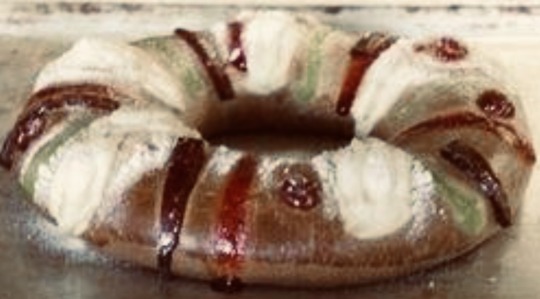
The clear sunny skies on that Sunday made for a pleasant Epiphany celebration enjoyed by many.
0 notes
Text
A New Holiday Tradition for the town of Sonoma

The 1200 block of Grove Street is a homespun holiday spectacular to rival that of the annual lighted snowmen at Cornerstone on Arnold Drive. “Dillonland - The Jolliest Place on Earth,” is a holiday menagerie of an array of characters and storylines from some of the most well-known and beloved genres of the past 70 years.
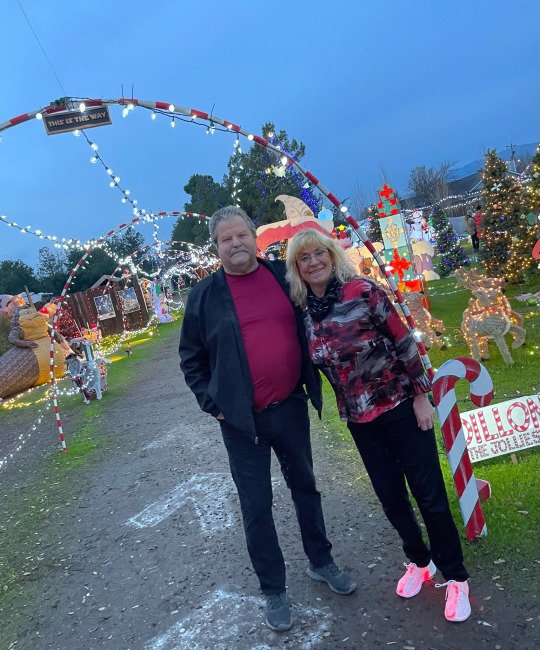
“Our son Dillon loves Christmas very much and for the past five years we as a family have been putting this together,” said Dillon’s mother, Karen Stall.
With Dillon as the visionary, his father Gary as the construction worker/builder and mom Karen as the artist/painter, the decorative-creativity keeps expanding.

“Dillon comes up with the designs and we follow along,” said Karen. In 2020 is when Dillon put his best and most work into it, establishing it as something to take the time to see.
There has been many local/neighborhood decorated houses and blocks in Sonoma over the years. But very few like “Dillonland” where people can actually walk through it and sit and enjoy for as long as they want.

Dillon wasn’t there when this reporter on assignment for the Sonoma Valley Sun stopped by the evening after Christmas. “He wanted to take a break,” said Karen, as the family starts preparing in November, opening the day after Thanksgiving.
‘Dillonland’ was closed on Christmas Day, much to the disappointment to local Sonoma residents like Mandy Cohen who made the effort to include it on the annual drive around to see the holiday lights. “I usually drive around my neighborhood after Christmas dinner and then to the plaza to see the lights,” said Cohen. “And when friends told me about the wonderful light display at Grove Street, I was disappointed and a bit puzzled that it was closed on Christmas,” she exclaimed.
In addition to being fans of Christmas, the Stall Family are big sports fans. “Sorry we weren’t open on Christmas,” said Karen to Cohen. “We didn’t want to miss the Forty-Niners game on Christmas.”

Amid the many different displays, which include different types and favorites; from The Grinch to Disney, to Charlie Brown and Snoopy, there’s a spot for the Forty-Niners.
Even though the Forty-Niners lost to the Baltimore Ravens on Christmas Day, the Stall Family is loyal. “Maybe, next year if the Forty-Niners have a game again on Christmas we will watch the game right here,” Karen said as she pointed to the large inflatable screen streaming the holiday classic movie ‘A Christmas Story.’ “That might be a great idea, get the sports fans out here too,” she said.

It’s their dedication and loyalty as a family and to the community that makes ‘Dillonland’ a unique and one-of-a-kind local holiday experience. Located at 1229 Grove Street, Dillonland is open from 5:30 to 9:00 PM in the evening for rest of the holiday season until Jan 7, 2024. “We will be here unless it rains,” said Karen. Limited parking is available directly across the street. For more details follow on Facebook and on Instagram @deckthehallswiththestalls.
0 notes
Text
A Pop up Nativity Scene Live…
Shepherds Surprise at a mobile home park

When long-time Sonoma resident Ellen Shepherd lamented to friends how much she missed not having the live nativity scene at her church St. Andrew Presbyterian on Arnold Drive in Sonoma this year, the cast and crew of the annual nativity scene showed by up at her door step. They surprised her unexpectedly the day before their Christmas Eve performance at the old Sonoma Mission complex near the historic Plaza in downtown Sonoma.
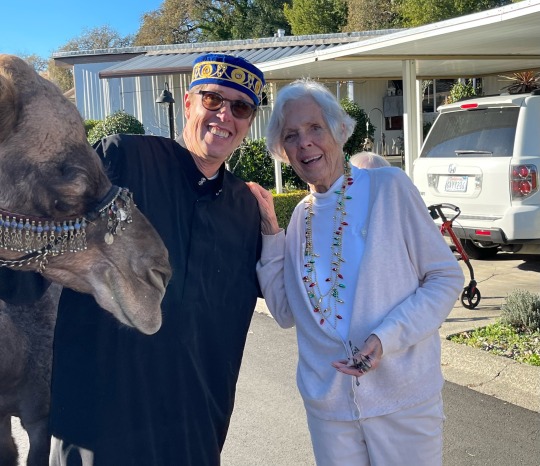
Neighbors near her home at Sonoma Oaks (just off of Sonoma Highway) were stunned and thrilled on Saturday afternoon, Dec. 23 to see a live nativity scene drive in and set up.
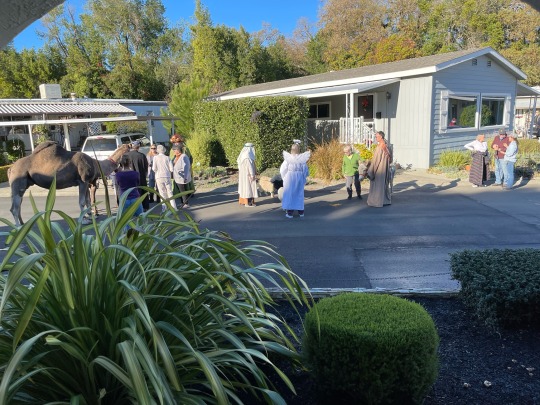
“This is amazing and wonderful,” exclaimed Shepherd, totally surprised as she walked out to greet the cast and crew who drove the menagerie of animals to Shepherd’s house enroute to prepare and set up the scene at the old Sonoma Mission barracks for Christmas Eve.
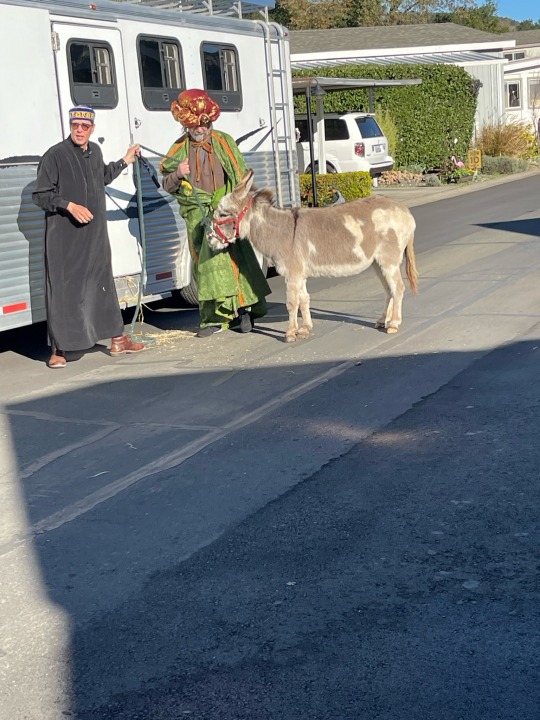
Brian Ness and Mike Weiss, operators of Vintage Kennel Club in Sonoma have been providing a live nativity scene in Sonoma at various churches since 2005. St. Andrew Presbyterian was one of several local Sonoma churches over the years that have had the rare opportunity to experience a live nativity scene presentation.
Back in 2018, Ness and his company of nativity performers made an appearance at St. Andrew to the delight of the congregation. Shepard who has been a member of St. Andrew Presbyterian for years (along with her late husband Harry) became very fond of Sahara the camel in the nativity scene. This past year, Sahara gave birth to a healthy baby camel calf.

“It’s only been in the past two years that we have performed the nativity scene at the Plaza,” said Ness. Previously, the nativity scene was not only performed at St. Andrew but at Sonoma Valley Community Church among other churches. Proceeds from donations gathered go to local charities helping those in need. This year donations/proceeds go to Sonoma Overnight Support (SOS - mission and outreach to feed the homeless and food insecure of the Sonoma Valley)

In 2021 Ness made arrangements with the Sonoma State Park, via the California State Parks Department to have the live nativity scene at the Plaza in an effort to make the experience more accessible to the public and easier to get to.

This year’s live nativity scene at the Plaza will be at the La Casa Grande courtyard at 20 East Spain Street, beginning at 1:00 PM, Christmas Eve, Dec. 24. For further details visit the California State Parks website.
Seen in photos are Brian Ness, Steve Klingberg, Kitty Brennick
Cathy Collier as an angel along with husband Mike Collier. Joseph is portrayed by Scott Walford
0 notes
Text
The Barbra Streisand Autobiography is an Omnibus, no doubt!

I was taken aback by how many chapters there are in Barbra Streisand’s autobiography; 59, wow!
Yet I have to say that her story and commentary is fascinating, especially for devoted fans.
One thing that surprised me the most was how much Streisand has accomplished as not only as a “superstar” artist but as a human being. Listening to her directly (I enjoy audio books the most) really does help the audience understand her better.
She is most authoritative when speaking about her life and experience in the theater and the arts. Her voice now mellowed with age does carry a certain assurance that truly speaks honestly and factually.
I liked just about everything she said about the arts, especially her work with acting and the entire “collaboration” of putting a production together from start to finish.
One thing I didn’t know about Streisand was that she got into singing because she wanted to act on stage and in movies. Obviously her tremendous voice served her well.
I was disappointed that she said little of her time in San Francisco. Especially when she performed in North Beach at The Hungry i.
Yet, I was very moved by the fact that she really did “pay her dues,” so to speak in attaining to the level of stardom she has achieved.
When she described what it was like to be on stage or in an acting class, I felt as if she is talking about the interior life of art itself. Acting and art students should listen and take to heart some of this book, seriously it’s important! This woman immediately recognized the distinction of a red that Rembrandt used in his paintings (a “Rembrandt red,”) as she calls it. And this was in her early days when she didn’t even attend an art history class.
Some aspects of her personal life are already known. But when you hear it directly from her there’s a resonance that’s deep, even if it seems familiar and cliche.
Like most celebrity books that speaks about the “behind-the-scenes” of movies and shows, it was interesting to hear about the details.
I was sad to hear that Streisand had a very difficult time with the move “Hello Dolly.” Actor, Walter Mathau treated her very badly and she knew instantly that she was too young (at age 27, then) to play the part of Dolly Levi, a middle aged widow, matchmaker, extraordinaire.
As a native SF Bay Area kid I was sad that San Franciscan Carol Channing was not chosen to portray Dolly in the movie. Even Streisand mentioned this. What was the director Gene Kelly thinking? Dolly was Channing’s signature role!
Channing proved she had the ability from her work on the hit film “Thoroughly Modern Milly.” Yet Streisand fulfilled her contract and remained professional.
What also struck me about Streisand is her ability to understand and articulate something intrinsically innate and deeply within herself or something. Like for example, her understanding of lighting and how to present material to an audience. What to wear, how to move around, etc.
Her taste is impeccable and she understands the creative process. That’s very clear in her work “Yentl.”
Speaking of “Yentl” Streisand took a lot of risks with that movie as well as another movie of hers called “Up The Sandbox.”
I was sad to learn that the author of ‘Yentl’ Issac Bashevis Singer didn’t like the movie and thought Streisand didn’t do it well.
Some time ago when I was speaking with a Rabbi’s son, (who now sells Kinish snacks) he mentioned that “Yentl, the movie is all about Barbra.” “It’s not anything about real Judaism,” he told me.
I imagine that type of criticism must have hurt Streisand very much. Especially since she clearly put a lot into that movie.
Let me clarify, I am not Jewish! But I thought the movie “Yentl” did a lot to shine a wonderful spotlight on Judaism and a bit of its history.
Isaac Bashevis Singer should have been pleased that someone like Streisand was willing to go the distance with his literary work. Ok, so it didn’t follow his vision exactly. But it did entertain and inspire, bringing a bit of the complexity of Judaism to the masses.
Also, Streisand helped make Singer’s work more approachable. Please note, I’m not an expert. But Singer writes about Jewish life similarly to that of author and playwright Sholem Aleichem. It was Aleichem’s work that inspired the hit musical “Fidler on The Roof.”
It seems to me, that Streisand tapped into that so that audiences could identify with the characters and life of those people. With all due respect, it seems to me that Singer was a bit of a recluse and preferred a sequestered life.
Streisand is not sequestered at all and it shows in all of her works.
Which, leads me into another dimension. Streisand of course is Jewish, especially as she portrayed comedian, Fanny Brice. Yet, Streisand transcends Judaism.
As I said before, there’s something innate within her that is universal and outstandingly unique.
She’s often imitated, parodied and sometimes made fun of. Yet it’s very clear to me, Streisand is a rare talent of a person that will not be duplicated. We probably won’t see anything truly like her again. God didn’t just “break the mold” as the old saying goes, he/(she) put an exclusive patent on it and it’s in heaven under his/her very special and exclusive contract.
2 notes
·
View notes
Text
‘Winter Market’ of The Marinship Shines upon Sausalito
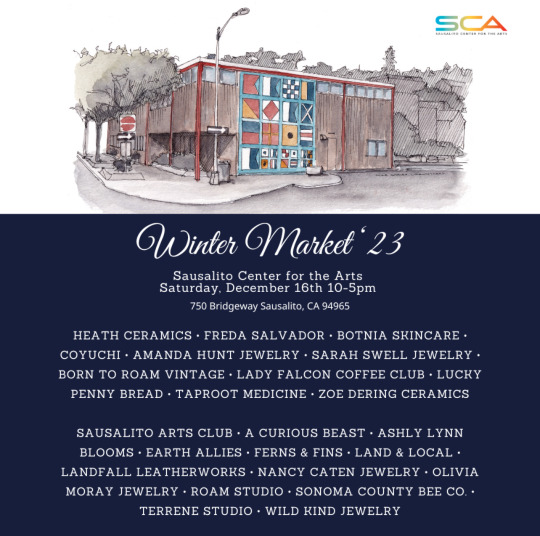
Like it’s name, which translates from Spanish to something as “grove of willows “ Sausalito is nestled peacefully a few miles north of Golden Gate Bridge attracting droves of tourists with stunning views of San Francisco in the distance. Yet few people know it was once a major shipyard of 20,000 workers and before that a railroad hub.
Forgotten remnants of what was “The Marinship” at Sausalito’s north end are now being further renovated and revitalized by Sausalito’s Economic Development Advisory Committee along with others in the endeavor.
“We are working very hard to bring business into this area,” said Monica Finnegan, speaking on behalf of the advisory committee. As the holiday season is approaching she and Justine Kahn are preparing for the Marinship Makers Fair (‘Winter Market’) on December 16.
Following on the heals of the Printmakers Exhibit and Holiday Sale at the newly established Sausalito Center for The Arts and a Holiday Open House at Spaulding Marine Center, The Marinship area will benefit greatly from the Makers Fair.
“Sausalito is home to over 7,000 people said Kahn and we’d like the residents on the hills to venture down to the Marinship to do their holiday shopping.”
Owner of Botnia Skin Care, set within the Marinship district, Kahn sees more than just potential in the Marinship; “it’s an economic ecosystem that’s blossoming,” she added.
Even as Sausalito was once known as a “hippie place” with it’s bohemian style houseboats the clear shoreline and mellow atmosphere lent itself to entrepreneurial activity. For as soon as shipbuilding stopped at the end of World War II, artisans, artists and craftsmen began to settle in.
In 1948 Edith & Brian Heath established Heath Ceramics. And while it has been described as having “small scale beginnings“ Health over the past 70 years has evolved into a pure and simple way of life and business. As now owned by Robin Petravic and wife Cathy, Heath Ceramics is one that shares a united creative heart, amid a variety of household and houseware expressions.
Another artisan-manufacturer that has made the Marinship area of Sausalito its homebase is FRĒDA SALVADOR handcrafted footwear.
Founded by Cristina Palomo Nelson and Megan Papay their shared love of design and knowledge of shoemaking cliqued. As a duo who envisioned a woman-owned company of their own, they traversed across Italy, and adjacent countries visiting Europe’s finest factories and tanneries. The two as founders were able to create a brand that struck the perfect balance between design and function.
Be it clothing such as Natasha Garrett’s Roam or Emma Casey’s Landfall Leatherworks, there’s something special about Sausalito and the Marinship area that gives empowerment to high-quality uniquely original artisan brands.
This is what Kahn and Finnegan want to feature and foster while highlighting this historic and underrated area of Sausalito.
With Spaulding Marine Center as its venue host the Marinship Makers Fair is poised to become a sought-after destination especially for the holiday season. “Sausalito is changing, said Kahn and so is the lens of Sausalito’s perspective upon itself and upon the world.”
As a magnet of tourism, Sausalito naturally encourages tremendous opportunities for business and entrepreneurial success. By spotlighting the Marinship area “we are encouraging the local people to come down from the hills and support its own local economy,” said Kahn.
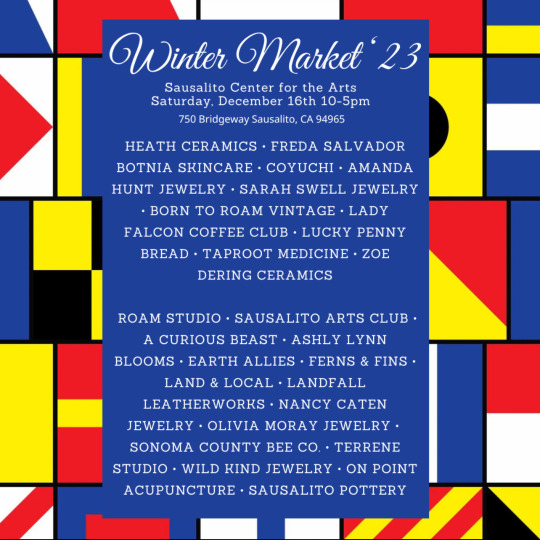
Last year’s annual Sausalito Holiday by The Bay was a success and has continued to grow. Kahn and Finnegan are committed to creating a similar annual holiday event. Yet the focus would be all about local artists, artisans and businesses. The Marinship ‘Winter Market’ on Saturday Dec. 16th will be held at Sausalito Center For The Arts (SCA) from 10:00 AM until 5:00 PM. The SCA is located at 750 Bridgeway (cross street is Anchor Street) in Sausalito, not far from the heart of downtown. For more information, visit the SCA website. Also see the info on Instagram.
0 notes
Text
Etchings: Those hues of gray and lines that stretch all the way to Rembrandt
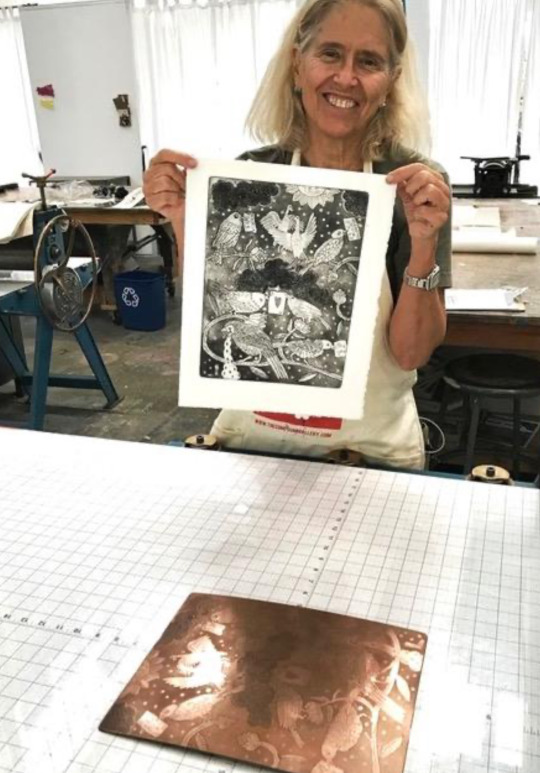
If you ask artist Dana Zed she will flat out tell you, “print isn’t dead!” She’s excited about being among the 17 participating artists in the Printmaking Marketplace exhibit and holiday sale event this December 9 & 10 at The Sausalito Center for the Arts (SCA).
A lifelong artist, in a career spanning 40 years, Zed creates in a variety of media ranging from painting to glass sculpture. Yet as she explains “etching is such a luscious expression to work with.”

There’s something special about it. “That line quality, texture and range of grays,” she said. “I’m doing my etching work the way Rembrandt did it, with rosin induced aquatints and acid baths and I love the way embossing looks,” she said.
“The specific etching technique that Rembrandt practiced is still used today,” said Isabella Lores-Chavez. She is Associate Curator, of European Paintings at Fine Arts Museums of San Francisco. “It involves a layer of wax applied to a copper plate that becomes the surface into which the etcher draws his composition with an etching needle,” Lores-Chavez added.
Zed points out that much of the work is a process. And, as she describes it, “there’s a dialogue between the artist and the work.”
“It’s never going to turn out with that kind of quality detail on a computer,” said Zed. While she does use digital technology in some of her art, etching is all hands on, no buttons to push or mouse to click.
Yes, it can get messy! Even so, the etching process and the results are unique and that can include some disappointments.“There’s a lot that can go wrong, says Zed, even if you are correctly following all the steps.” "Those ‘disappointments’ lead to more working on the plate until it is finished. “It may not be what I was aiming for,” said Zed, "but often it’s better than my original intent.”
Paying close attention is key. The outcome of a work could change unexpectedly because of something small like the timing of maybe just seconds in the acid, or on the hot plate or in the rosin box, as Zed said.
“It’s a ‘challenge’ said Zed. But that’s the beauty of it. Her favorite subject for etchings are birds, “anthropomorphic in settings, a commentary on humans sort of “tongue-in-cheek” irony type of humor.
“I’ve done florals but birds are a favorite and I stick with the traditional black and white/grayscale,” Zed exclaimed.
Zed mentioned that even the type and thickness of paper can make a difference. “That too can either add or take away from the intended work.” Zed affirmed that even as she has tried the “new” non-toxic way of etching: such as electro-etching. But for her the way Rembrandt did it is best, although quite toxic.
As Zed explained. “Toxicity is why people use these new medium-techniques of soy based inks over oil based inks and Baldwin ground over the traditional Charbonnel.”
Etchings for Rembrandt was a way he could make his work more accessible and affordable to a wider audience.
While there can be a debate about the merger between art and commerce for Zed “Creativity is everywhere but artists have a vocation,” she said. Dedication to art is what separates it from being a hobby to that of a profession.
Printmaking is media that she prizes very much and one that truly requires artistry and mastery of skill. Zed suggests that printmaking, etching in particular has a clearer rubric for success than other media; abstract painting for example.
Zed along with the 17 other artists participating in the exhibit & holiday market sale are looking forward to having their art reach the public directly. “This is a rare opportunity,” said Shiva Pakdel, executive director of Sausalito Center for The Arts. “And a chance for people to meet and talk with the artists,” she added.

Sausalito Print Marketplace and Exhibit is for one weekend only, Saturday December 9 & Sunday December 10, 2023. Doors open at 10:AM. Sausalito Center for The Arts is located 750 Bridgeway at Achor Street, not far from the heart of downtown Sausalito.
Admission is free. For more information visit the Sausalito Center for The Arts (SCA) website.
0 notes
Text
The Significance of Food in Dickens Novels

Members of the press were invited to attend the annual press reception for the opening weekend of the Dickens Christmas Fair on November 18 & 19. It was an afternoon of performances by actors portraying characters from ‘A Christmas Carol’ and other novels alongside a rousing group singing songs familiar of the 19th Century.

The Green Man Inn was overflowing with people and food, which were all designed/prepared to be reminiscent of author, Charles Dickens’ time as depicted in his many novels. The South Hall area of The Cow Palace Arena & Event Center, Daly City was transformed by Red Barn Productions and (the Christmas fair’s founder) the Patterson family into a replica of Old London circa 1820 to 1870.

Be it costume, decor, style of speech and even the overall lightning, the cast and crew of hundreds painstakingly recreate what Ron and Phyllis Patterson referred to as an “immersion theater“ experience.

Visitors are transported to Dickens’ world and are provided a glimpse into what life was like more than 150 years ago. Along with the merriment there’s the food. Throughout the Fair there’s an array of foods and drinks to choose from. Food prices at the Dickens Fair range from $2 candies to $32 for “High Tea.”

Press members and guests at The Green Man Inn were given generous portions of meat pies, Scotch Eggs and sausage rolls.

Paired with the selection of a Victorian recipe of ginger beer, cider and or a bit of sparkling wine the culinary offerings that Sunday afternoon were as guest John Vigil described it, “hearty.”

Attendees such as Susie Straight and Glenn Tryon were impressed with the festive atmosphere and were both delighted by the food. “And, the opportunity to dress up, said Straight, the period-costume designs, some are exquisite, she added.

As Thanksgiving approaches, with roast turkey, many people are contemplating a feast. And, much of what people today consider a Christmas dinner is from the likes of Dickens and the Victorian era.
Pudding, custard and pie, especially meat pies, were a prized commodity among the people of Dickens time.
As food writer Katie Pix and food historian Pen Vogler explain. While some form of a pie has existed since ancient times, the meat pie was popular because it was convenient and a way to extend it just a bit.
Spices, herbs, vegetables-filling could be added and then as a condensed food item, easily transported and stored. Keep in mind that refrigeration wasn’t invented yet. Dickens mentioned a savory pie in his novel ‘Great Expectations.’ Young Pip was able to take the meat pie his sister had made to the escaped man hiding in the churchyard.
To bake, boil or stew something like meat, milk and eggs was a way to preserve them at least for a short period. And, while Dickens in his ‘A Christmas Carol’ certainly made plum pudding the star of a Christmas dinner table, the lack of food was a concern for Dickens.
A meager amount of food, such as stale bread or bits and scraps were common for less fortunate people in Victorian England.
What’s ironic is that in ‘A Christmas Carol’ Scrooge eats little so to hold more tightly on to his money. Whereas his employee, Bob Cratchet struggles to use what little money he earned to give his family a holiday celebration.
“Dickens’s most abiding influence, says Vogler, is his conviction that everybody has the right to sit down together and enjoy the same food.”
As a food historian, Vogler notes that social class and position are part of the food culture. “Crucially, the Cratchits’ Christmas was not part of any ecclesiastical or charitable space but enjoyed by a poor family in their own home.”
It’s a fact that as the Industrial Revolution was making advancements that could improve food production and distribution, yet, a caste system prevailed.
“Dickens was challenging a culture that regarded food as necessarily exclusive,” said Vogler. “These are conflicts in a war for status and control, in which food is deployed to show that ‘you are what you eat,’ and as Vogler points out it’s also about a people divided “by what they don’t eat,” she said.
The poor in Dickens’ time wouldn’t have been able to afford much of anything fresh, especially fresh meat and vegetables. As food writer Katie Pix emphasizes, ingredients and quantities were crucial. “The first recorded recipe for apple pie was written in 1381 in England, and called for figs, raisins, pear and saffron.”
Highly prized, saffron was precious as gold. And by the time Dickens wrote ‘Oliver Twist’ the once prosperous estate located in a south-east section of London that had harvested saffron was by then a wretched place. It is in what is called ‘Saffron Hill’ where the character Fagin and his thieves live and hide.
Dickens wrote ‘Oliver Twist’ to criticize the poverty in England. He saw how poverty was exacerbated by punitive legislation enacted in 1834 called “The Poor Law.” It served only to increase the use of poor houses and work houses to further enslave the poor and hungry.
Depravation (want) and ignorance are what the Spirit of Christmas Present warns Scrooge to be wary of. The giant spirit of Christmas Present gives Scrooge that “milk of human kindness” a metaphor for compassion. His tall presence and sense of abundance makes clear that the only lack in Scrooge is a fullness of life, love and generosity.

Food is essential and during holidays it is not only a way to celebrate but a way of showing appreciation, gratitude and love. This is illustrated in many of Dickens’ novels; most notably in ‘A Christmas Carol.’

The Dickens Christmas Fair continues for five consecutive weekends, from the weekend of November 19 through December 17. Open from 10: AM to 6:PM the fair has something for everyone.
For tickets and more information visit the Dickens Christmas Fair website
0 notes